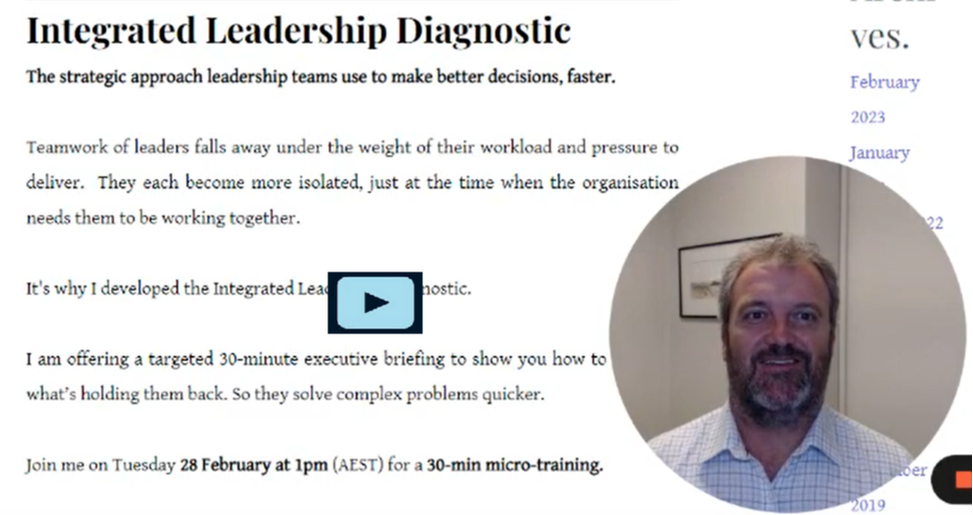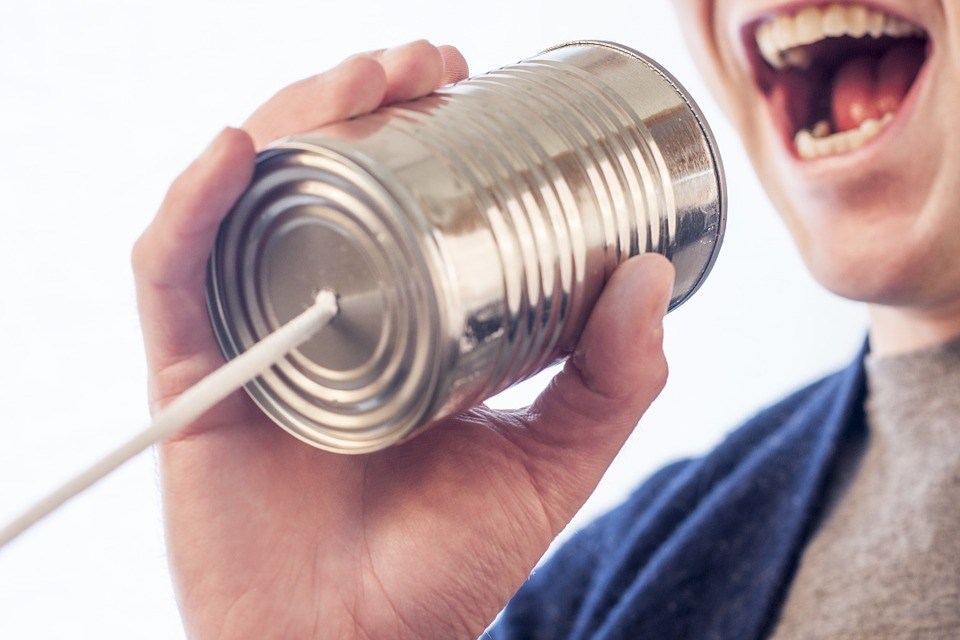|
Is this you?
The purpose, the “why”, for my entire business, is to help people improve their felt experience of life. To help you clarify and achieve your success. It is why I do this work and why I built the My Ataraxy Process (TM). This session has been specially designed to help you understand:
As senior leaders and business owners you take responsibility for other people’s wellbeing. You will often forget about and sacrifice yourselves. This is a chance for you to investigate an opportunity for you. Take back control of your life, career, and move ahead with confidence and energy. Join me on Wednesday 31 May at 9.00 am (AEST). Reserve your spot below. “I thought I would have to be stressed for the rest of my life. Work challenges have changed. They’ve gone from hard and done, to complex, ever-evolving and continuous. Far beyond the capability of any one person to solve. Your people are deluged with information overload and tasks to attend to. Under pressure, they hunker down and start to isolate. People start to act out and can play small, petty and at times seem quite childish. And business opportunities get mired in process and detail. It’s why I created the Integrated Leaders Power-Up. The strategic way Senior Executives get their leadership teams working together. And create traction towards important goals.
I am offering a 45-minute executive briefing to step out exactly what you need to do to integrate your leadership team. To move them from stuck and overwhelmed, to dynamic and effective. Join me on Friday 28 April, at 9am (AEST). You can sign up below. an outcome far better than I would have expected The Parley Framework An effective tool to help you bridge the gap between warring factions within your organisation.
Under pressure well meaning, talented people can develop conflicted and polarised positions. Us & Them silos arise and adults can act out in immature ways. Business challenges become harder to solve; as people become less flexible and slower to respond to commercial opportunities. The polarised positions feel like a chasm, and can deteriorate into a “winner/loser” dynamic. It's why I created The Parley Framework. Simple strategies to help my clients become peacemakers. I am offering a targeted 30-minute executive briefing to show you how to start bringing the factions together. So that they begin to integrate and work more collaboratively. >> Join me on Tuesday 28 March at 1pm (AEST) for a 30-min micro-training. For senior executives that want their teams to move from divided to cohesive. Can you make it? >> Please register below. Here’s what one client had to say about it: we got an outcome far better than expected "There had been a significant dispute growing between two leaders in the business, I had to meet with one to address the situation and get people working together again. I ran the meeting very differently than I would have without your guidance and it made a huge difference, we got an outcome far better than I would have expected." S.T., General Manager, Automation Systems Manufacturing Industry Integrated Leadership Diagnostic The strategic approach leadership teams use to make better decisions, faster. Teamwork of leaders falls away under the weight of their workload and pressure to deliver. They each become more isolated, just at the time when the organisation needs them to be working together. It's why I developed the Integrated Leadership Diagnostic. I am offering a targeted 30-minute executive briefing to show you how to pinpoint what’s holding them back. So they solve complex problems quicker. Join me on Tuesday 28 February at 1pm (AEST) for a 30-min micro-training. For senior executives that want their teams to move from disjointed to dynamic. Can you make it? Please register below. If your People are open, clear of mind and attentive,
If your context (aka Culture) allows for purposeful interactions and integrations, and If they are cognitively diverse and have the Skills to leverage each others difference, and problem solve together - you will have a very powerful team. One of the simplest and often overlooked contributor to the above is to have people pay attention, to be present. Thought this might help. It is a simple A4 poster that you can share with your team about the importance of attending to what you are doing - minimising distraction. Really valuable and simple piece of knowledge to help people prevent mistakes (including injury) and do good quality work. My clients find it useful, so I thought I'd share it with you. Let me know if you find it helpful. Meetings are a significant investment by an organisation.
Ideal world - people come into a common space to work together and solve problems effectively and quickly. Reality - people attend meetings simply because it is in their calendar and treat the meetings as events to 'endure', interrupting their real work. They OUGHT to be big time savers, but in reality they are more often the biggest waste of time (possibly second only to email - this email is the obvious exception 🙂) in a leader's week. But when your organisation seems addicted to meetings, how can you make the best of that time? First question: "Do I need to be there at all?" Many of the meetings we attend are habituated, simple updates, or you're included to 'keep you in the loop' rather than contribute to outcome. So ask sincerely, "Do I need to be at this meeting?" If not, communicate with the convenor and get taken off the invite list (don't just not show up). For the ones that do matter: YOUR role in these time-expensive events is simple:
How well you do this will determine your influence. These four tips will make a difference. 1. Clear the decks Be present - BE there at the meeting! An obvious point, but it is too easy to be unfocused and distracted, thinking about other work issues. Distractions undermine your ability to understand and communicate, you are just not as clever when you are not paying full attention. Distractions (eg second screen whilst on a Zoom/Teams meeting) make you miss stuff - that you don't know you've missed. You may FEEL like you're nailing the meeting and getting some admin done at the same time; truth is you are doing neither to your best ability. Just like when you can see others who are distracted - they will see you're not really there. It is disrespectful of your time and theirs. 2. Think it through Do the thinking work and come prepared. The meeting must have a clear agenda or outcome. So, think it through, and be clear about the outcome and purpose of the meeting. Be clear about where the discussion could go and work to it 'on point'. The whole point of a meeting is to harness the power of many. To leverage from DIFFERENT perspectives, heuristics, and skills. So allow the meeting to think it through, the different brains applied to the context is the very point of the meeting. It is not to simply hear what the boss thinks and deploy. 3. Check your mind-state Your effectiveness will be compromised if you are frustrated, tired, rushing, or stressed. In those mind-states, people are less able to communicate effectively. Less able to understand other people's perspectives. They are more likely to make face-saving / short-term decisions, engage in blame/guilt, and self-protective behaviour. And those mind-states are contagious. Even a marginal downgrade in mood across a meeting can have a material effect on creativity and problem-solving. Put simply the meeting 'disintegrates' and you lose the main benefit of holding a meeting in the first place; access to different perspectives that the different minds have, to solve the problems faced. There IS NO POINT having a meeting where the participants are not listening to each other. If you, or you can see that others, are in one of those mind states; simply pause for a few minutes, focus on your breath and dial the whole thing back 10 or 20% and then recommence. 4. Build good meeting and conversation habits
The more you and your team get used to thinking in this way, the more productive and easier the meetings will become.  People can be reluctant to speak with their boss or colleagues about their mood or mind state, but it doesn't need to be that difficult. One way to help people speak up, learn about, and support mental health is to treat it as less of a big deal to talk about. To be clear, mental health IS a big deal, but treating it this way can make it harder for simple discussions to take place. Like physical health, it is a gradient and there is no point waiting until someone is morbidly unhealthy to talk about health. Consider a score out of 10, where 10 is feeling at your absolute best, firing on all cylinders, on top of your game, 5 is pretty average or flat, 3 is quite under the pump, and a score of 0 or 1 is a person who is in real trouble. On any given day we are likely to oscillate around an average, and if we were able to, we would take steps to edge that average score up over time. There are days when we will feel low; say a 2 or 3, but provided they are infrequent and the average is reasonably solid, then all we need to do is engage in some simple self-care strategies (which is often, just wait - eg take a day or two off to get some space and perspective) to lift us out of the hole we feel we are in. The thing we want to avoid is having our average score reduce over time, such that we become stuck, trapped in an internal climate that causes every day to be challenging. Mental Health is seen as significant and people might not speak up because they don't want it to be 'a thing'. This is a form of denial. They wait until they really feel 'beyond blue', overwhelmed, or in nervous breakdown territory before they seek help. From that point, the journey back is just that much farther. The freedom to speak about our state of mind on a given day can be improved if we recognise the gradient between a 'down day' or a tough week at one end, to chronic mental health challenges at the other. People don't want to make a fuss. Normalising conversations enables people to take simple action earlier. Wouldn't it be great for people to be able to easily discuss their mental fitness, without it needing to be "a thing", without it being a note on the employee file? How much more could we enable people to intervene before it gets too deep, and encourage those who are really feeling it to join the conversation and put their hand up? A consequence of feeling out of sorts is that you also feel alone or isolated. in fact isolation is both a cause AND a symptom of feeling low - these conversations help people gain comfort in understanding that they are not alone. Flexibility comes from allowing a middle ground. The freedom to say "I'm really feeling under the pump at the moment", and to be supported simply and without fuss. "Yeah? I've noticed you've been a little quiet. Have you thought about ..........? Have you tried.....?" Organisations that encourage the casual conversation (without blame, guilt, fear, and judgment) will improve the well-being of more people, and be more able to support those who are doing it really tough. Helping those with 'mild symptoms' is a gateway to allowing those with more severe experiences to get the help they need. How do you normalise conversations about mental fitness and health? We've all had the sensation of intuition. "I don't know why, but this doesn't feel right" or "I just know that this will work." We bet on a horse that "I've just got a feeling is bound to win" and are shocked when it doesn't.
We revere this sensation as though it is some deeper truth– more true than other evidence. This is a false view. The best way to think about intuition is in a similar way to how we think about sight, sound and other more 'direct' senses. We know that for the most part our sight is pretty good for what it has emerged to do. We can navigate our world, find what we are looking for without bumping into things. We rely on our sight to keep us safe. So far so good. However, we also know that our eyes can deceive us. What we see isn't a photograph of what is there, but a constructed - imagined - representation of what is most likely to help us navigate. Our brain's best guess. adjusted for usefulness. We've all seen various visual illusions where, for example, two equal lines look different lengths based on how the line is positioned. Because we can measure the truth with a ruler we accept that our eyes are wrong, marvel at the sensation and go about our day. We tend not to be this scientific with 'intuition' because it is difficult to measure the accuracy against anything objective. I coach my clients to think of intuition like a higher level aggregation of other senses and memories that provides a 'felt measure of confidence'. Our brain is looking to predict safety. It makes a guess (prediction) measures this against the sensory data (light, sound etc) and memory patterns (how well does this data match existing memory patterns and what do those patterns tell us about how safe we are). The nagging sense that something isn't right is your brain saying "there is something about this that doesn't allow a prediction of safety" or "there is something about this that is similar to a previous dangerous experience" both of these will produce an intuition of nagging doubt. Such doubt is worth listening to, acknowledging and in the case of making a risky decision or action, worth stepping back and checking before jumping. However, you can see a few ways it can be wrong. For example, what if the person you feel uneasy about just happens to look like someone who caused you harm 20 years ago. Your brain may find 'something fishy about this person' for no other reason than the coincidence of appearance. What if the nagging doubt is about something you know to be on balance good for you, such as establishing a new exercise habit. But when your brain 'checks' with memory patterns for what this might mean for you and doesn't have any evidence for safety having never joined a gym before, or finds risk to what I consider normal or good ("I don't want to be end up like one of those gym junkies"), you can end up letting your "it just didn't feel right" to be an excuse for not acting in your best interest. My message is pay attention to your intuition. It is powerful and helpful for the most part. If your brain says "slow down and check" then listen! Especially when it comes to physical safety. Take a precautionary approach– if you feel 'too confident' you probably are. So check yourself, check evidence, look more closely, and think further into the future– "how is this likely to play out?". If you feel danger or unease - act to make sure you and those around you are safe first – seek additional sources of evidence to help you determine the risk more clearly. Intuition is a higher level sense so use it. However, in a competition between "good science" and "my gut"– science wins regardless of how I feel about it. The application of the science of mind as it relates to managing people, stress, conflict, change and personal productivity turns happiness into a commercially smart leadership priority. Building personal leadership and authentic happiness focuses on the solution – not the symptom.
The skills to improve authentic happiness are teachable. These skills reduce stress and the possibility of conflict whilst also improving resilience, strategic thinking, customer service and productivity. It’s like fitness training for mental health. You are teaching your key people how to self-manage their responses to situations in the moment when it matters. Imagine what your workplace would be like if your key people were fully engaged and firing on all their mental cylinders more of the time. Like a hydrofoil; they rise above the chop of daily life and enjoy a powerful and smooth run. The deliberate focus on teaching people how to apply the science of mind to build authentic happiness will do more for the effectiveness and attitude of your key people than any other type of personal leadership development. Does Executive Coaching work over distance, or does the coaching always need to be "In Person"?
|
|
Copyright 2019: Donovan Ataraxy Pty Limited. All rights reserved.






